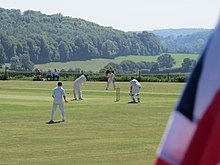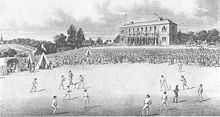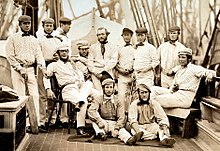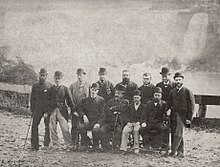Cricket
The sport of cricket has a known history beginning in the late 16th century England. It became an established sport in the country in the 18th century and developed globally in the 19th and 20th centuries. International matches have been played since the 19th-century and formal Test cricket matches are considered to date from 1877. Cricket is the world's second most popular spectator sport after association football (soccer).[1]
Internationally, cricket is governed by the International Cricket Council (ICC), which has over one hundred countries and territories in membership although only twelve currently play Test cricket.
The game's rules are defined in the "Laws of cricket". The game has various formats, ranging from T-10(Ten-10) played in around 90 minutes to Test matches which can last up to five days.
Early cricket
[edit]Main article: History of cricket to 1725
Origin
[edit]Cricket was created during Saxon or Norman times by children living in the Weald, an area of dense woodlands and clearings in south-east England that lies across Kent and Sussex.[2] The first definite written reference is from the end of the 16th century.
There have been several speculations about the game's origins, including some that it was created in France or Flanders. The earliest of these speculative references is from 1300 and concerns the future King Edward II playing at "creag and other games" in both Westminster and Newenden. It has been suggested that "creag" was an Old English word for cricket, but expert opinion is that it was an early spelling of "craic", meaning "fun and games in general".[3]
It is generally believed that cricket survived as a children's game for many generations before it was increasingly taken up by adults around the beginning of the 17th century. Possibly cricket was derived from bowls, assuming bowls is the older sport, by the intervention of a batsman trying to stop the ball from reaching its target by hitting it away. Playing on sheep-grazed land or in clearings, the original implements may have been a matted lump of sheep's wool (or even a stone or a small lump of wood) as the ball; a stick or a crook or another farm tool as the bat; and a stool or a tree stump or a gate (e.g., a wicket gate) as the wicket.[4]
First definite reference
[edit] John Derrick was a pupil at the Royal Grammar School, then the Free School, in Guildford when he and his friends played creckett circa 1550
John Derrick was a pupil at the Royal Grammar School, then the Free School, in Guildford when he and his friends played creckett circa 1550In 1597 (Old Style – 1598 New Style) a court case in England concerning an ownership dispute over a plot of common land in Guildford, Surrey, mentions the game of creckett. A 59-year-old coroner, John Derrick, testified that he and his school friends had played creckett on the site fifty years earlier when they attended the Free School. Derrick's account proves beyond reasonable doubt that the game was being played in Surrey circa 1550, and is the earliest universally accepted reference to the game.[5][6]
The first reference to cricket being played as an adult sport was in 1611, when two men in Sussex were prosecuted for playing cricket on Sunday instead of going to church.[7] In the same year, a dictionary defined cricket as a boys' game, and this suggests that adult participation was a recent development.[5] In an account of a case brought before the King's Bench in 1640, it is recorded that a cricket match "between the Weald & Upland" took place "about 30 yeares [sic]" previously.[8]
Derivation of the name of "cricket"
[edit]A number of words are thought to be possible sources for the term "cricket". In the earliest definite reference, it was spelled creckett. The name may have been derived from the Middle Dutch krick(-e), meaning a stick; or the Old English cricc or cryce meaning a crutch or staff, or the French word criquet meaning a wooden post.[4] The Middle Dutch word krickstoel means a long low stool used for kneeling in church; this resembled the long low wicket with two stumps used in early cricket.[9] According to Heiner Gillmeister, a European language expert of the University of Bonn, "cricket" derives from the Middle Dutch phrase for hockey, met de (krik ket)sen (i.e., "with the stick chase").[10]
It is more likely that the terminology of cricket was based on words in use in south-east England at the time and, given trade connections with the County of Flanders, especially in the 15th century when it belonged to the Duchy of Burgundy, many Middle Dutch[11] words found their way into southern English dialects.[12]
The Commonwealth
[edit]After the Civil War ended in 1648, the new Puritan government clamped down on "unlawful assemblies", in particular the more raucous sports such as football. Their laws also demanded a stricter observance of the Sabbath than there had been previously. As the Sabbath was the only free time available to the lower classes, cricket's popularity may have waned during the Commonwealth. However, it did flourish in public fee-paying schools such as Winchester and St Paul's. There is no actual evidence that Oliver Cromwell's regime banned cricket specifically and there are references to it during the interregnum that suggest it was acceptable to the authorities provided that it did not cause any "breach of the Sabbath". It is believed that the nobility in general adopted cricket at this time through involvement in village games.[5]
Gambling and press coverage
[edit]Cricket thrived after the Restoration in 1660 and is believed to have first attracted gamblers making large bets at this time. It is possible, as believed by some historians, that top-class matches began.[13][14] In 1664, the "Cavalier" Parliament passed the Gaming Act 1664 which limited stakes to £100, although that was still a fortune at the time, equivalent to about £19,000 in present-day terms [15]. Cricket had become a significant gambling sport by the end of the 17th century, as evidenced in 1697 by a newspaper report of a "great match" played in Sussex which was 11-a-side and played for high stakes of 50 guineas a side.[7]
With freedom of the press having been granted in 1696, cricket for the first time could be reported in the newspapers. But it was a long time before the newspaper industry adapted sufficiently to provide frequent, let alone comprehensive, coverage of the game. During the first half of the 18th century, press reports tended to focus on the betting rather than on the play.
18th-century cricket
[edit]Main articles: History of cricket to 1725, History of cricket (1726–1750), History of cricket (1751–1775), and History of cricket (1776–1800)
Patronage and players
[edit]Gambling introduced the first patrons because some of the gamblers decided to strengthen their bets by forming their own teams and it is believed the first "county teams" were formed in the aftermath of the Restoration in 1660, especially as members of the nobility were employing "local experts" from village cricket as the earliest professionals.[5] The first known game in which the teams use county names is in 1709 but there can be little doubt that these sort of fixtures were being arranged long before that. The match in 1697 was probably Sussex versus another county.
The most notable of the early patrons were a group of aristocrats and businessmen who were active from about 1725, which is the time that press coverage became more regular, perhaps as a result of the patrons' influence. These men included the 2nd Duke of Richmond, Sir William Gage, Alan Brodrick and Edwin Stead. For the first time, the press mentions individual players like Thomas Waymark.
Cricket expands beyond England
[edit]Cricket was introduced to North America via the English colonies in the 17th century,[12] probably before it had even reached the north of England. In the 18th century it arrived in other parts of the globe. It was introduced to the West Indies by colonists[12] and to the Indian subcontinent by East India Company mariners in the first half of the century.[16][circular reference] It arrived in Australia almost as soon as colonisation began in 1788. New Zealand and South Africa followed in the early years of the 19th century.[5]
Cricket never caught on in Canada, despite efforts by the upper class to promote the game as a way of identifying with the "mother country". Canada, unlike Australia and the West Indies, witnessed a continual decline in the popularity of the game during 1860 to 1960. Linked in the public consciousness to an upper-class sport, the game never became popular with the general public. In the summer season it had to compete with baseball. During the First World War, Canadian units stationed in France played baseball instead of cricket.[17][18]
Development of the Laws
[edit]See also: Laws of Cricket
It's not clear when the basic rules of cricket such as bat and ball, the wicket, pitch dimensions, overs, how out, etc. were originally formulated. In 1728, the Duke of Richmond and Alan Brodick drew up Articles of Agreement to determine the code of practice in a particular game and this became a common feature, especially around payment of stake money and distributing the winnings given the importance of gambling.[7]
In 1744, the Laws of Cricket were codified for the first time and then amended in 1774, when innovations such as lbw, middle stump and maximum bat width were added. These laws stated that "the principals shall choose from amongst the gentlemen present two umpires who shall absolutely decide all disputes". The codes were drawn up by the so-called "Star and Garter Club" whose members ultimately founded the Marylebone Cricket Club at Lord's in 1787. The MCC immediately became the custodian of the Laws and has made periodic revisions and recodifications subsequently.[19]
Continued growth in England
[edit]The game continued to spread throughout England, and, in 1751, Yorkshire is first mentioned as a venue.[20] The original form of bowling (i.e., rolling the ball along the ground as in bowls) was superseded sometime after 1760 when bowlers began to pitch the ball and study variations in line, length and pace. Scorecards began to be kept on a regular basis from 1772; since then, an increasingly clear picture has emerged of the sport's development.[21]
The first famous clubs were London and Dartford in the early 18th century. London played its matches on the Artillery Ground, which still exists. Others followed, particularly Slindon in Sussex, which was backed by the Duke of Richmond and featured the star player Richard Newland. There were other prominent clubs at Maidenhead, Hornchurch, Maidstone, Sevenoaks, Bromley, Addington, Hadlow and Chertsey.
But far and away the most famous of the early clubs was Hambledon in Hampshire. It started as a parish organisation that first achieved prominence in 1756. The club itself was founded in the 1760s and was well patronised to the extent that it was the focal point of the game for about thirty years until the formation of MCC and the opening of Lord's Cricket Ground in 1787. Hambledon produced several outstanding players including the master batsman John Small and the first great fast bowler Thomas Brett. Their most notable opponent was the Chertsey and Surrey bowler Edward "Lumpy" Stevens, who is believed to have been the main proponent of the flighted delivery.
It was in answer to the flighted, or pitched, delivery that the straight bat was introduced. The old "hockey stick"–style of bat was only really effective against the ball being trundled or skimmed along the ground.
First-class cricket began in 1772. Three surviving scorecards exist of 1772 matches organised by the Hambledon Club which commence a continuous statistical record. Those three matches were all between a Hampshire XI and an England XI, the first played at Broadhalfpenny Down on 24 and 25 June. The two leading online archives begin their first-class coverage with this match which is numbered "first-class no. 1" by ESPNcricinfo and "f1" by CricketArchive. Broadhalfpenny Down continued in regular use by Hambledon/Hampshire teams until 1781.
 A Game of Cricket at The Royal Academy Club in Marylebone Fields, now Regent's Park, depiction by unknown artist, c. 1790–1799
A Game of Cricket at The Royal Academy Club in Marylebone Fields, now Regent's Park, depiction by unknown artist, c. 1790–179919th-century cricket
[edit]Main articles: History of cricket (1801–1825), History of English cricket (1826–1845), and History of English cricket (1846–1863)
The game also underwent a fundamental change of organisation with the formation for the first time of county clubs. All the modern county clubs, starting with Sussex in 1839, were founded during the 19th century. No sooner had the first county clubs established themselves than they faced what amounted to "player action" as William Clarke created the travelling All-England Eleven in 1846. Though a commercial venture, this team did much to popularise the game in districts which had never previously been visited by high-class cricketers. Other similar teams were created and this vogue lasted for about thirty years. But the counties and MCC prevailed.
The growth of cricket in the mid and late 19th century was assisted by the development of the railway network. For the first time, teams from a long distance apart could play one other without a prohibitively time-consuming journey. Spectators could travel longer distances to matches, increasing the size of crowds. Army units around the Empire had time on their hands, and encouraged the locals so they could have some entertaining competition. Most of the Empire embraced cricket, with the exception of Canada.[22]
In 1864, another bowling revolution resulted in the legalisation of overarm and in the same year Wisden Cricketers' Almanack was first published. W. G. Grace began his long and influential career at this time, his feats doing much to increase cricket's popularity. He introduced technical innovations which revolutionised the game, particularly in batting.
International cricket begins
[edit]The first ever international cricket game was between the US and Canada in 1844. The match was played at the grounds of the St George's Cricket Club in New York.[23]
In 1859, a team of leading English professionals set off to North America on the first-ever overseas tour and, in 1862, the first English team toured Australia. Between May and October 1868, a team of Aboriginal Australians toured England in what was the first Australian cricket team to travel overseas.[24]
In 1877, an England touring team in Australia played two matches against full Australian XIs that are now regarded as the inaugural Test matches. The following year, the Australians toured England for the first time and the success of this tour ensured a popular demand for similar ventures in future. No Tests were played in 1878 but more soon followed and, at The Oval in 1882, the Australian victory in a tense finish gave rise to The Ashes.
South Africa became the third Test nation in 1889.





